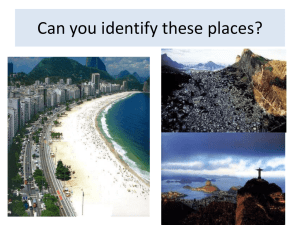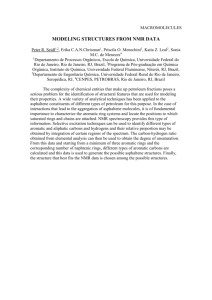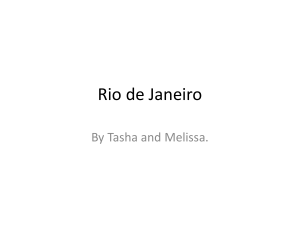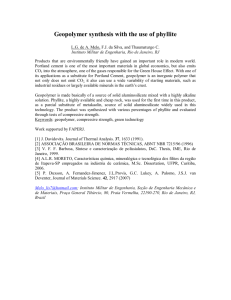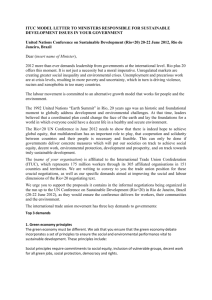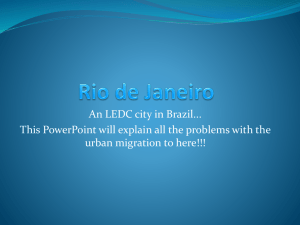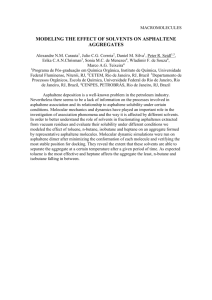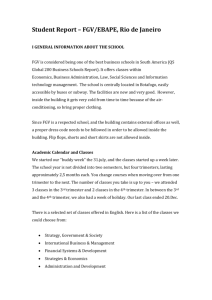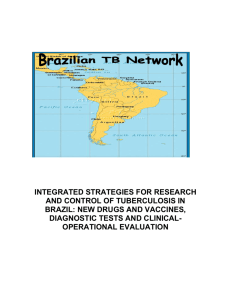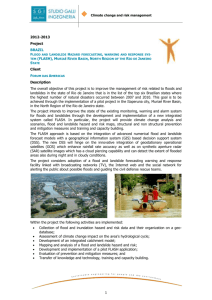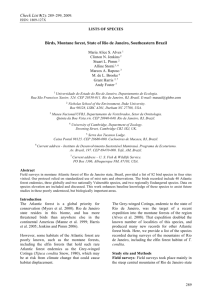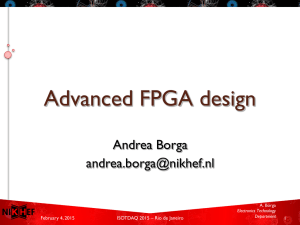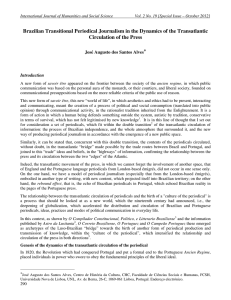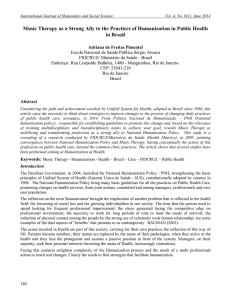The City and the Library - BNDigital
advertisement
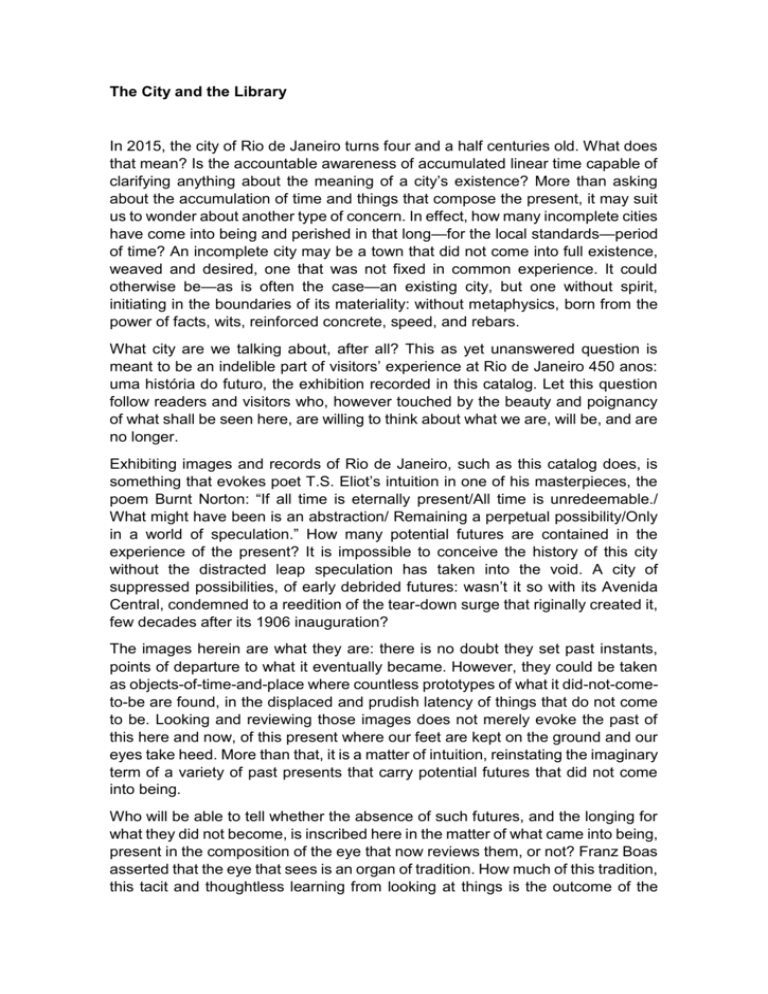
The City and the Library In 2015, the city of Rio de Janeiro turns four and a half centuries old. What does that mean? Is the accountable awareness of accumulated linear time capable of clarifying anything about the meaning of a city’s existence? More than asking about the accumulation of time and things that compose the present, it may suit us to wonder about another type of concern. In effect, how many incomplete cities have come into being and perished in that long—for the local standards—period of time? An incomplete city may be a town that did not come into full existence, weaved and desired, one that was not fixed in common experience. It could otherwise be—as is often the case—an existing city, but one without spirit, initiating in the boundaries of its materiality: without metaphysics, born from the power of facts, wits, reinforced concrete, speed, and rebars. What city are we talking about, after all? This as yet unanswered question is meant to be an indelible part of visitors’ experience at Rio de Janeiro 450 anos: uma história do futuro, the exhibition recorded in this catalog. Let this question follow readers and visitors who, however touched by the beauty and poignancy of what shall be seen here, are willing to think about what we are, will be, and are no longer. Exhibiting images and records of Rio de Janeiro, such as this catalog does, is something that evokes poet T.S. Eliot’s intuition in one of his masterpieces, the poem Burnt Norton: “If all time is eternally present/All time is unredeemable./ What might have been is an abstraction/ Remaining a perpetual possibility/Only in a world of speculation.” How many potential futures are contained in the experience of the present? It is impossible to conceive the history of this city without the distracted leap speculation has taken into the void. A city of suppressed possibilities, of early debrided futures: wasn’t it so with its Avenida Central, condemned to a reedition of the tear-down surge that riginally created it, few decades after its 1906 inauguration? The images herein are what they are: there is no doubt they set past instants, points of departure to what it eventually became. However, they could be taken as objects-of-time-and-place where countless prototypes of what it did-not-cometo-be are found, in the displaced and prudish latency of things that do not come to be. Looking and reviewing those images does not merely evoke the past of this here and now, of this present where our feet are kept on the ground and our eyes take heed. More than that, it is a matter of intuition, reinstating the imaginary term of a variety of past presents that carry potential futures that did not come into being. Who will be able to tell whether the absence of such futures, and the longing for what they did not become, is inscribed here in the matter of what came into being, present in the composition of the eye that now reviews them, or not? Franz Boas asserted that the eye that sees is an organ of tradition. How much of this tradition, this tacit and thoughtless learning from looking at things is the outcome of the longing for what has not come into being? Like a life, a city too is the outcome of the possibilities that have been subtracted from it. We ought to admit the invincible presence of the strange dialectics— or enigma, all the same—that cause enabling effects to emerge from the very acts of decimation. This is all about placing the past back into the future. Henri Bergson, who did his very best to deal with the issues of time and duration, ensures this hereby pretension. In his 1919 book L’Énergie Spirituelle, he suggested that, if the past did not survive in the present, there would be no psychological perception of duration, but merely of “instantaneousness”. There are, however, different modes of duration. One may bring the past as a way to introduce the circumstances that explain the future, for instance. This is not the suggestion here, because nothing is explained; everything is merely shown. It would be more appropriate to challenge the latter about the modes in which it dealt with the former than to exact from the past an explanation of the future. In rather straightforward terms, the suggestion is to think about the effects of the present upon the past, and not to stick to the easy key of seeking clarification through the linear reconstruction of the temporal series. Before doesn’t always explain after; the latter should, if at all possible, tell us why it came into being. It is all about conceiving the future, at the same time, as an outcome of what did happen and what did not happen. The feeling of duration may shelter a shadow, madly fulfilled with what could have been. What place other than a library could possibly shelter the materials for this speculation, for this playful chronological therapy? Or perhaps a city library, whose past is a collection of potential futures? Biblioteca Nacional’s decision to integrate the ensemble of cultural initiatives around the ephemeris of Rio de Janeiro’s 450 anniversary was made after recognizing the historical interdependence established with the library’s home city. Ever since it was created in 1810, the Biblioteca Nacional has brought forth two indelible lines: a permanent institution of the Brazilian State and people; and an institution well set in the life of the city of Rio de Janeiro. It is the latter aspect that must be highlighted: how can we conceive the history of the Biblioteca Nacional without incorporating the presence of its home city in the library’s basic identities? At the same time, how can we conceive the city, including all of its memories and potential futures, without what is kept in here? Questions of that sort have been around the choice for this intended outlook: to show the city of Rio de Janeiro in the—or of the—Biblioteca Nacional. And since the acts of showing are never innocent, particularly when they deal with time, exhibiting fragments of what this city has once been brings along an invitation to conceive how it could have been and how it will be. An exhibition about the city is, after all, a form of intervention, which happens because of the possibility of ref lecting about the experience of being in this city. As local as we may be, we share one of the basic Brazilian myths: that the future takes off from the present in Faustian fashion, owing nothing to the past, with no links whatsoever. In our obsession with the future, we are unstoppable chronocides. Compatible evidences of that can easily be found in the history of the city: we build, we tear down, we erase, we add. The city, as the exhibition clearly indicates, is an open oeuvre, coexisting with drives for life and for destruction. In it, we shall never have the feeling of completed cities. Nevertheless, a city is always an inward abyss. Whatever new dimensions get to be included, it is in the nature of supplementary acts to add complexity to life, since they travel simultaneously in different directions of tense complementariness. Indeed, the main contemporary intervention in the design of the city of Rio de Janeiro is steered by the prospect of restoration: as the Avenida Perimetral was demolished, the right to a seascape is returned to the city; and streetcars are brought back, too. Part of the city reinvents itself on the assumption of a desired recovery of what it has lost. Dissipated possibilities are recovered and, thus, a certain attraction to the past—driven by the intuition that, in many ways, we have once been better off—shapes the designs of the future. We are lulled by excavations, craving to see the guts of a land from bygone times, where—if chance will have it— there lie unfathomable truths and secrets. Looking at the crevices on the ground and exercising the arts of an archaeologic voyeurism. Acceding to a world of stones juxtaposed by whale oil, guessing who might have trodden those grounds. A city opened in exhumation, which requires it as a necessary step into the future. We adore the future, granted; but when we think about what we are as subjects of this city, we dig, we open up holes and address the center of the earth with crucial questions that we all ask: Who are we? Who or what has made us what we are? What can we do with it? A city that, in spite of being chronocide and an early devourer of its artifices, requires the presence of the past as its launching pad into the future. We will soon be versed in the arts of de-claiming land; we shall have seas and lakes back; we shall behold again the Saco de São Diogo, the Praia do Alferes, the Ponta do Calabouço. Who knows, we might find the body of Dana de Teffé, a major mystery in the history of the city and a significant concern for Rio de Janeiro’s immortal Carlos Heitor Cony*. Why can’t we go so far as to anticipate reassembling some of the torn down hills around the city? A city focused on the center of the earth! Others require the air and altitudes. There are still others that are set in deserts, in pure inorganic matter. Meanwhile, we never let go of being captive to a telluric vocation, to a desire of organically extracting the sense embedded in tectonic layers. We dig tunnels, we move the earth, we tear down hills, we claim the sea. A quickearth city, enemy of immobility and permanence. As we discover our buried traces, we become sweet and remembering. We are taken by a sadness and warmth that are typical of those who recall their childhood. Digging deeper, discovering worlds that were once around these vicinities, pricking our ears to the countless collection of potentials, set in these instances hereby, to try to answer the questions that started this text. Speculating about what we will be and what we could have been. How much intuition of the future and present tense depends on the exercise of imagination prompted by the grammatical mode of the conditional future? One’s experience with the world is made of memory matter—an expression that aforementioned Carlos Heitor Cony used as the title of his fifth book. Memory of what happened, memory of that which was not given to happen! How many cities, after all, are there in this city? How many archaeologies are possible in this city? That cannot be told, not even by approximation. We know they are there, however, because of the signs that are finely kept in Rio de Janeiro’s major library—the Biblioteca Nacional! Rio de Janeiro, June 2015 Renato Lessa Biblioteca Nacional, President Myriam Lewin Executive Director and Acting Director of the Biblioteca Nacional * Dana Fitscherova, judia tcheca, foi casada com o Embaixador Manuel de Teffé, de quem adquiriu o sobrenome que lhe daria triste fama. Em 1961 desapareceu, em meio a uma viagem entre o Rio de Janeiro e São Paulo. Nunca mais se soube dela, viva ou morta. Foi um dos casos mais rumorosos da crônica criminal carioca dos anos 1960.
